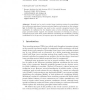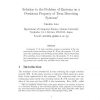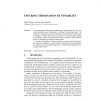CTRS
1992
14 years 4 months ago
1992
ded abstract of this paper is published in the proceedings of the 3rd International Workshop on Conditional Term Rewriting Systems, Pont- -Mousson, 1992 1
ALP
1994
Springer
14 years 4 months ago
1994
Springer
Kennaway proved the remarkable result that every (almost) orthogonal term rewriting system admits a computable sequential normalizing reduction strategy. In this paper we present ...
WADT
1997
Springer
14 years 4 months ago
1997
Springer
The dynamic behavior of rule-based systems (like term rewriting systems 24], process algebras 27], and so on) can be traditionally determined in two orthogonal ways. Either operati...
RTA
1997
Springer
14 years 4 months ago
1997
Springer
We present a technique to prove innermost normalisation of term rewriting systems
TRSs
automatically. In contrast to previous methods, our technique is able to prove innermost n...
CTCS
1997
Springer
14 years 4 months ago
1997
Springer
Monads can be used to model term rewriting systems by generalising the well-known equivalence between universal algebra and monads on the category Set. In [L¨u96], this semantics ...
PLILP
1998
Springer
14 years 5 months ago
1998
Springer
A property P of term rewriting systems is persistent if for any many-sorted term rewriting system R, R has the property P if and only if its underlying term rewriting system (R), ...
IFIP
2004
Springer
14 years 6 months ago
2004
Springer
A term terminates if all its reduction sequences are of finite length. We show four type systems that ensure termination of well-typed π-calculus processes. The systems are obtai...
FOSSACS
2004
Springer
14 years 6 months ago
2004
Springer
Several types of term rewriting systems can be distinguished by the way their rules overlap. In particular, we define the classes of prefix, suffix, bottom-up and top-down system...
RTA
2005
Springer
14 years 6 months ago
2005
Springer
Abstract. We show that the structures of binding algebras and Σmonoids by Fiore, Plotkin and Turi are sound and complete models of Klop’s Combinatory Reduction Systems (CRSs). T...
BIRTHDAY
2005
Springer
14 years 6 months ago
2005
Springer
Huet and L´evy (1979) showed that needed reduction is a normalizing strategy for orthogonal (i.e., left-linear and non-overlapping) term rewriting systems. In order to obtain a de...





